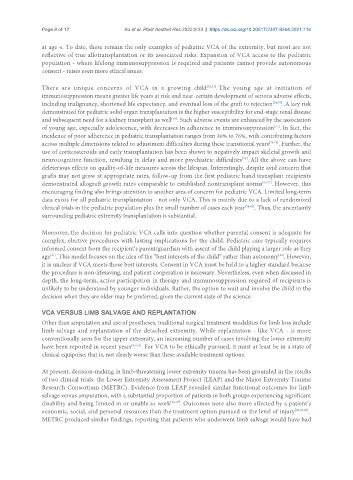Page 88 - Read Online
P. 88
Page 8 of 17 Xu et al. Plast Aesthet Res 2022;9:33 https://dx.doi.org/10.20517/2347-9264.2021.116
at age 4. To date, these remain the only examples of pediatric VCA of the extremity, but most are not
reflective of true allotransplantation or its associated risks. Expansion of VCA access to the pediatric
population - where lifelong immunosuppression is required and patients cannot provide autonomous
consent - raises even more ethical issues.
There are unique concerns of VCA in a growing child [72,73] . The young age at initiation of
immunosuppression means greater life years at risk and near-certain development of serious adverse effects,
including malignancy, shortened life expectancy, and eventual loss of the graft to rejection [74,75] . A key risk
demonstrated for pediatric solid organ transplantation is the higher susceptibility for end-stage renal disease
and subsequent need for a kidney transplant as well . Such adverse events are enhanced by the association
[76]
[77]
of young age, especially adolescence, with decreases in adherence to immunosuppression . In fact, the
incidence of poor adherence in pediatric transplantation ranges from 30% to 76%, with contributing factors
across multiple dimensions related to adjustment difficulties during these transitional years [78,79] . Further, the
use of corticosteroids and early transplantation has been shown to negatively impact skeletal growth and
neurocognitive function, resulting in delay and more psychiatric difficulties . All the above can have
[73]
deleterious effects on quality-of-life measures across the lifespan. Interestingly, despite avid concern that
grafts may not grow at appropriate rates, follow-up from the first pediatric hand transplant recipients
demonstrated allograft growth rates comparable to established nontransplant norms [69,71] . However, this
encouraging finding also brings attention to another area of concern for pediatric VCA. Limited long-term
data exists for all pediatric transplantation - not only VCA. This is mainly due to a lack of randomized
clinical trials in the pediatric population plus the small number of cases each year [74,80] . Thus, the uncertainty
surrounding pediatric extremity transplantation is substantial.
Moreover, the decision for pediatric VCA calls into question whether parental consent is adequate for
complex, elective procedures with lasting implications for the child. Pediatric care typically requires
informed consent from the recipient’s parent/guardian with assent of the child playing a larger role as they
age . This model focuses on the idea of the “best interests of the child” rather than autonomy . However,
[82]
[81]
it is unclear if VCA meets those best interests. Consent in VCA must be held to a higher standard because
the procedure is non-lifesaving, and patient cooperation is necessary. Nevertheless, even when discussed in
depth, the long-term, active participation in therapy and immunosuppression required of recipients is
unlikely to be understood by younger individuals. Rather, the option to wait and involve the child in the
decision when they are older may be preferred, given the current state of the science.
VCA VERSUS LIMB SALVAGE AND REPLANTATION
Other than amputation and use of prostheses, traditional surgical treatment modalities for limb loss include
limb salvage and replantation of the detached extremity. While replantation - like VCA - is more
conventionally seen for the upper extremity, an increasing number of cases involving the lower extremity
have been reported in recent years [83-91] . For VCA to be ethically pursued, it must at least be in a state of
clinical equipoise; that is, not clearly worse than these available treatment options.
At present, decision-making in limb-threatening lower extremity trauma has been grounded in the results
of two clinical trials: the Lower Extremity Assessment Project (LEAP) and the Major Extremity Trauma
Research Consortium (METRC). Evidence from LEAP revealed similar functional outcomes for limb
salvage versus amputation, with a substantial proportion of patients in both groups experiencing significant
disability and being limited in or unable to work [92-97] . Outcomes were also more affected by a patient’s
economic, social, and personal resources than the treatment option pursued or the level of injury [92,93,96] .
METRC produced similar findings, reporting that patients who underwent limb salvage would have had

